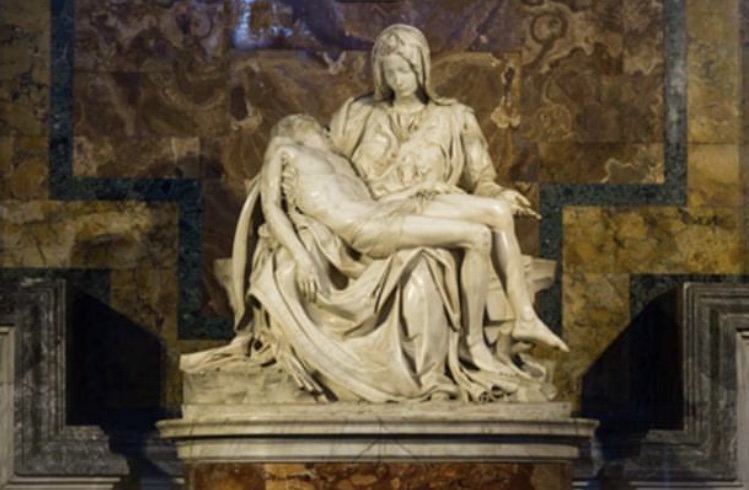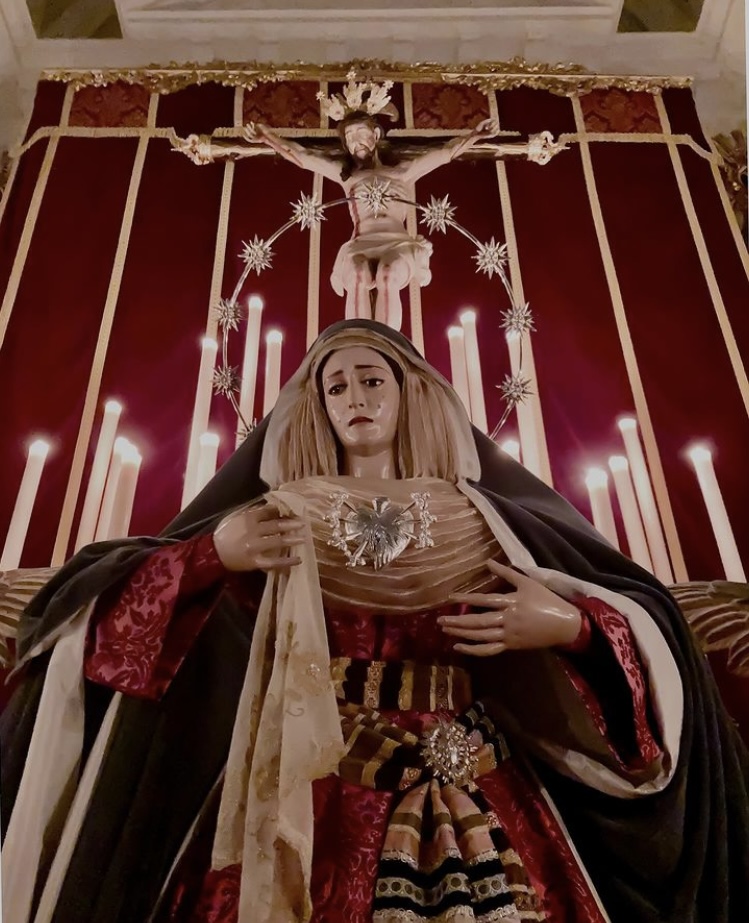Mary: Mater Dolorosa, the sorrowful mother
Mary grieves over her dead son; hence, she is Mater Dolorosa, the sorrowful mother. In 1499, Michelangelo conveyed this maternal sentiment in his masterpiece known as the Madonna della Pietà, a marble sculpture of Mary cradling the mortal body of Jesus at Golgotha.
It is a work of Renaissance art and, btw, the only piece Michelangelo ever signed.

Michelangelo’s “Pieta” sculpture at St. Peter’s Basilica in Rome. Image: ancient_origins/IG
Our Catholic Faith tells us that the Son of God, the Second Person of the Blessed Trinity, was destined to become the Son of Man in Mary’s womb. God’s invitation to save mankind was closely linked to the personal decision of one woman set apart from all the rest, “Blessed art thou, amongst women” (Luke 1:42).
We Christians dare so boldly to postulate that Mary’s role in salvation history was divinely planned from all eternity. YHWH GOD “wanted the free cooperation of a creature. For this, from all eternity God chose for the mother of his Son a daughter of Israel, a young Jewish woman of Nazareth in Galilee” (Catechism of the Catholic Church, 488).
This clarifies what St. Paul writes: “When the fullness of time came, God sent his son, born of a woman, born a subject of the law…” (Galatians 4:4). By consenting to the divine invitation and conforming to the divine will (Annunciation, Luke 1:38), Mary, a daughter of Eve, became the Mother of God, or Theotokos, assuming her role in the mystery of the Incarnation of the Second Person of the Blessed Trinity.
Heaven rejoiced as hell trembled in fear when Jesus, the perfect epiphany of the Most High God, was not only made a man; he was made a Jew. Verbum caro factum est, “and the Word was made Flesh!) (John 1:14).
The flesh of Jesus is the flesh of Mary
Mary gave birth to Jesus, “the One who saves,” and nourished and prepared his mind, soul, and body to become the ultimate sacrifice. In salvation history, Mary gave us the ecce Homo, the High Priest and the Victim! Sacerdos et Victima!
When the body of historical Jesus was subjected to all forms of punishment—scourged, spat upon, tortured, crowned with thorns, and nailed on the cross—every Christian remembers during the Holy Week that every square inch of the Divine Savior was knitted in Mary’s womb.

Mater Dolorosa. Image: materdolorosa/IG
The Mater Dolorosa witnessed how Jesus was stripped of his clothing, tied to a pillar, and whipped several times until his flesh hung in shreds.
Caro Jesu caro Mariae est, says Saint Alphonsus de Liguori in The Glories of Mary (New York: Kennedy and Sons, 1888). It means “the flesh of Jesus is the flesh of Mary” one hundred percent hers because Jesus was conceived by the Holy Spirit in the Virgin Mary, who “knew no man.” The tender flesh of him scourged and crucified all came from Mary’s flesh. Joseph was Jesus’ foster father.
Mary gave us the Victim, the Lamb of God, to be slaughtered using a human body, with her own DNA or 46 chromosomes, shedding human blood to “wash away our sins.”
Agnus Dei, qui tollis peccata mundi, miserere nobis!
From Annunciation (March 25 in the Catholic calendar) to Christmas (December 25)—nine full months in the womb of Mary—the Victim, the Lamb of God, was getting ready to be sacrificed on the altar of the cross.
A dear payment for crimes against God, Mother Nature and humanity
During Holy Week, we pause for a while and contemplate the deep wounds at his back, knees, both sides of the body, shoulders and the front—every square inch of his body was pierced and beaten, his muscles and skins ripped off, and his face distorted. We look at his wounded heart and his head crowned with thorns. Horrible!
On Good Friday, Jesus carried his cross up the hill of Golgotha and was crucified. Whenever we look at the crucifix, we recall our broken promises and God’s unbroken promise, of our badness and God’s Goodness, of our idiocy to hate God and God’s idiocy to love us so much.
But why such horrible punishment during the Holy Week, wherein every square inch of Jesus’s body was wounded and disfigured?
Paraphrasing St. Athanasius of Alexandria, Jesus paid a debt He did not owe because we owed a debt we could not pay (De Incarnatione). His passion and death were the high price God paid for our sins! Abortions, rape, worship of money, human trafficking, clerical sexual abuse, greed, sins of women, sins of men, sins of the past, the present, and the future, sins committed in high places, sins done in dark alleys, wicked designs, evil intentions…and more deadly sins.
Scotism is a medieval school of philosophy named after 13th-century philosopher and Franciscan theologian John Duns Scotus. The Scotists found it inappropriate that sin, which God abhors so much, should be the occasion for the most complete manifestation of the all-powerful God.
However, the Sacred Scriptures (Divine Revelation) assign human sin that began in the First Fall of Adam and Eve as the primary motive of Christ in assuming a human nature, suffering, dying, and thereby saving humanity. YHWH God “loved us and sent his Son to be the expiation for our sins” (1 John 4:10). The great doctor of the Church, Saint Augustine, explains by saying that “if mankind had not fallen, the Son of Man would not have come… (Sermon 174, 2).
“We adore you, O Christ, and we praise you, for by your holy cross you have redeemed the world.”
Priest and Victim today
The Holy Week of yesterday continues today and will go on until the end of time, so much so that the Sacrifice of the Holy Mass that we attend today is the same as the historical sacrifice of Jesus in Calvary 2000 years ago.
In such a declaration of our Faith, it is implicit, therefore, that the Holy Priesthood is essentially the same sacrifice of Jesus, the Victim on the altar. It is a recall of YHWH’s command to Abraham to prepare a sacrifice and the boy Isaac’s question, “Where is the lamb?”
The New Testament fulfills the Old Testament. Thus, it becomes necessary for the Savior to die in order to become the victim, for a Savior without dying is not a victim. “Had he not died,” Saint Alphonsus de Ligouri poses a perfect question: “Where should we find the victim that the priests of the New Law now offer?”
God so designed that the “Lamb of God, who takes away the sins of the world,” the Priest and Victim born of the Virgin Mary, would be the sacrificial Victim in the Holy Mass celebrated by our clergy. Jesus instituted the Holy Priesthood to make present and available at every altar.
Holy Mary, Mother of God, pray for us sinners. Amen!
José Mario Bautista Maximiano is the author of “Church Reforms – Semper Purificanda,” Volume One (Claretian, 2023) and the author of “MCMLXXII: 500-Taong Kristiyano,” Volume Two (Claretian, 2021), declared the “Best Book in Ministry” during the 16th Cardinal Sin Catholic Book Awards 2022.

